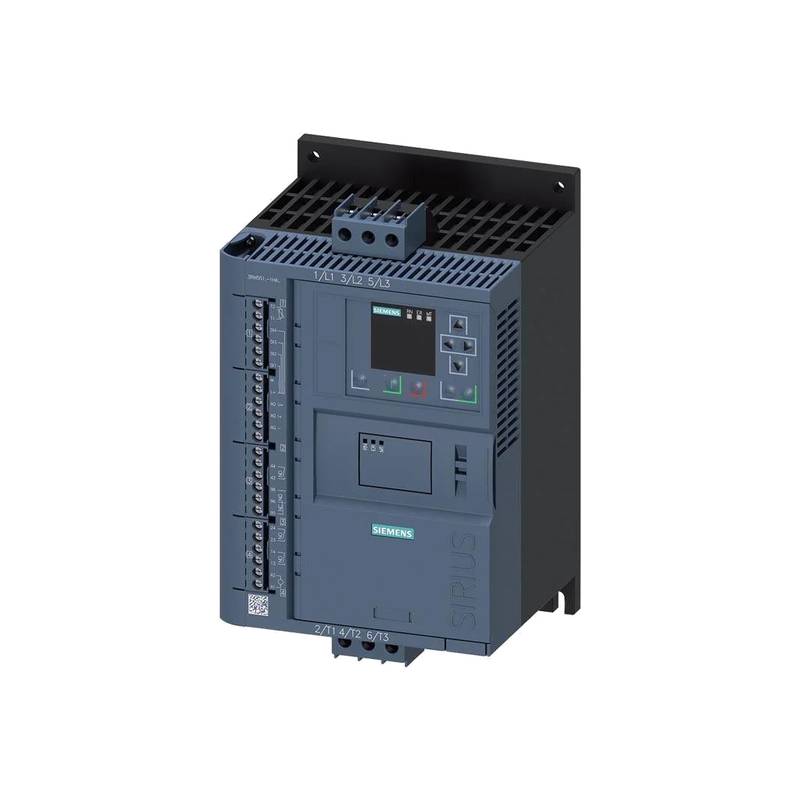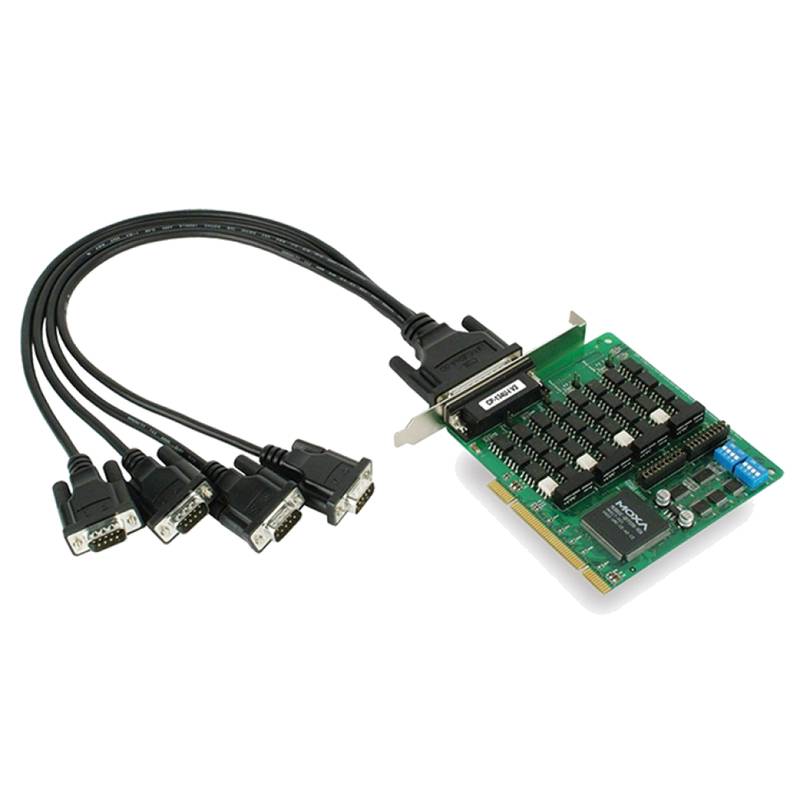
The Moxa ioLogik E1211 4-Channel DO Digital Output Remote I/O module stands as a robust and efficient solution for industrial automation, offering direct control over digital outputs in remote locations. Its key advantages include high reliability, ease of integration, and compact design, making it ideal for demanding environments. Core features encompass four isolated digital output channels, supporting both sink and source configurations, with a rapid output response time of 1 millisecond. It operates within an industrial temperature range of -40 to 85°C and boasts an MTBF of over 1,000,000 hours, ensuring dependable performance. Power is supplied via a 12-48 VDC input, and it features an RS-485 serial interface for communication, compatible with Modbus RTU protocol.
Product Specifications
| Feature | Specification |
| :------------------ | :-------------------------------------------------- |
| Digital Output | 4 isolated channels |
| Output Type | Sink and Source configurable |
| Max. Load Current | 300 mA per channel |
| Output Response Time| 1 ms |
| Communication Interface| 1 RS-485 port (2-wire) |
| Protocol | Modbus RTU |
| Power Input | 12-48 VDC |
| Power Consumption | 1.1 W @ 24 VDC |
| Operating Temperature| -40 to 85°C |
| Storage Temperature | -40 to 85°C |
| Humidity | 5-95% RH (non-condensing) |
| Dimensions | 31.5 x 70 x 96 mm |
| Mounting | DIN-rail, wall, or panel mount |
| MTBF | > 1,000,000 hours |
Core Features & Market Positioning
The Moxa ioLogik E1211 distinguishes itself through its inherent robustness and versatility, a common hallmark of Moxa's industrial automation offerings. Its ability to support both sink and source output configurations offers significant flexibility in connecting to a wide array of digital actuators, relays, and indicators, simplifying system design and reducing the need for specialized interfaces. The rapid 1 ms output response time is critical for applications demanding precise timing and quick reaction, such as high-speed packaging lines or process control loops where even minor delays can impact efficiency or product quality. Positioned as a cost-effective yet high-performance remote I/O solution, the E1211 excels in applications where reliability and straightforward integration are paramount, often finding favor in distributed control architectures where a central PLC manages multiple remote I/O points.
Key Application Scenarios
This 4-channel digital output module is ideally suited for a diverse range of industrial applications. It is frequently employed in building automation for controlling lighting, HVAC systems, and access control mechanisms, where remote management of output states is essential for energy efficiency and operational convenience. In manufacturing environments, the ioLogik E1211 can be utilized for signaling alarms, activating machinery components, controlling conveyor belts, or managing pneumatic valves in discrete manufacturing processes. Its rugged design and wide operating temperature range also make it a strong candidate for deployments in harsh conditions, such as oil and gas facilities for remote valve actuation or environmental monitoring systems for controlling pumps and indicator lights. Furthermore, it serves effectively in water and wastewater treatment plants for managing pump operations and status indicators.
Practical System Integration Guidance
Integrating the Moxa ioLogik E1211 into an existing industrial network is streamlined due to its adherence to the widely adopted Modbus RTU protocol over RS-485. Installation typically involves mounting the unit on a standard 35mm DIN rail, or via wall or panel mount options, followed by connecting the power supply (12-48 VDC) and the RS-485 communication lines. For digital outputs, ensure proper wiring to the connected devices, respecting the maximum load current of 300 mA per channel. For control, a master device, such as a PLC, industrial PC, or SCADA system supporting Modbus RTU, can poll and write to the E1211's output registers. For instance, to turn on the first digital output (DO1), a Modbus master would typically write to Holding Register 1001 (Function Code 06 for single register write) with a value of 65535 (all bits ON). To turn it off, it would write a value of 0.
Operation and Risk Mitigation
The Moxa ioLogik E1211 is designed for operational simplicity and reliability, minimizing potential risks through its inherent design and robust construction. Its isolated digital output channels prevent ground loops and protect connected equipment from voltage transients. The wide operating temperature range (-40 to 85°C) and high MTBF rating ensure consistent performance even in challenging industrial settings. In terms of risk mitigation, users should always adhere to local electrical codes and ensure proper grounding of the system. Overloading the digital output channels beyond the 300 mA limit is a primary risk; therefore, verify the current requirements of connected actuators. Firmware updates, if available, should be applied following Moxa's documented procedures to address any potential bugs or enhance security. Regular inspection of wiring connections is also recommended to prevent intermittent faults or potential short circuits.
Scalability & Long-Term Value
The ioLogik E1211 offers significant scalability and long-term value within an industrial automation architecture. Its Modbus RTU communication allows for easy integration into existing SCADA systems or PLCs that support this ubiquitous protocol. Multiple E1211 modules, or a combination with other Moxa ioLogik devices featuring analog inputs or digital inputs, can be daisy-chained on the same RS-485 bus, enabling a distributed I/O network managed by a single master. This approach is cost-effective for expanding control points without requiring extensive rewiring or additional communication infrastructure. Furthermore, the device's compatibility with modern IIoT platforms is often achieved through gateways that translate Modbus RTU to protocols like MQTT or OPC UA, facilitating data acquisition and remote monitoring in the context of Industry 4.0 initiatives, thus ensuring its relevance and utility for years to come.
Frequently Asked Questions
What are the main advantages of using the Moxa ioLogik E1211?
The Moxa ioLogik E1211 offers robust digital output control in remote industrial settings. Its key benefits include high reliability with a long MTBF, and flexible output configurations supporting both sink and source types. This module ensures quick response times critical for automated processes.
This remote I/O module provides a compact and durable solution for harsh environments. Its wide operating temperature range and isolated outputs reduce the risk of equipment damage and ensure stable operation. The E1211 simplifies system expansion through its standard Modbus RTU protocol.
Its primary advantage lies in its cost-effectiveness for distributed I/O applications. The module's straightforward integration and minimal maintenance requirements contribute to lower total cost of ownership over its operational lifespan.
What technical specifications are crucial for the Moxa ioLogik E1211?
The ioLogik E1211 features four isolated digital output channels capable of handling 300 mA per channel. Its output response time is a rapid 1 millisecond, essential for precise control applications. It operates on a 12-48 VDC power supply.
Communication is facilitated via an RS-485 serial interface using the Modbus RTU protocol, allowing seamless integration with master devices. The module is designed to function reliably across a broad industrial temperature range of -40 to 85°C.
Key technical parameters also include its compact dimensions for easy mounting and a Mean Time Between Failures (MTBF) exceeding 1,000,000 hours, underscoring its industrial-grade durability.
How can the Moxa ioLogik E1211 be integrated into an industrial control system?
Integration is achieved through its RS-485 serial port using the Modbus RTU protocol, a widely supported standard in industrial automation. A master device, such as a PLC or SCADA system, communicates with the E1211 to command its digital outputs.
Wiring involves connecting the power supply to the designated terminals and establishing communication links via the RS-485 terminals. The E1211 can be part of a multi-drop network, allowing several devices to share the same communication bus.
Configuration typically involves setting the Modbus slave address and baud rate on the E1211 to match the master's settings, ensuring successful data exchange for controlling connected actuators or indicators.
What are common applications for the Moxa ioLogik E1211?
This module is widely used in building automation for controlling lights, HVAC, and access systems remotely. It offers efficient management of outputs in decentralized control scenarios. Its versatility suits various infrastructure management tasks.
In manufacturing, the E1211 excels at controlling machinery, signaling alarms, and managing pneumatic valves in discrete production lines. Its fast response time is beneficial for real-time process control.
It is also deployed in harsh environments like oil and gas or water treatment plants for actuating pumps and valves, and for monitoring critical status indicators.
How is the Moxa ioLogik E1211 powered and what are the power requirements?
The Moxa ioLogik E1211 requires a DC power supply within the range of 12 to 48 VDC. This wide input voltage range provides flexibility in selecting suitable power sources in different industrial settings.
Each module typically consumes a modest amount of power, around 1.1 W when operating at 24 VDC. This low power consumption makes it energy-efficient for large-scale deployments or battery-powered applications.
Users must ensure the power source is stable and adequately rated to handle the module's consumption and any potential inrush currents when outputs are activated.
What type of communication does the Moxa ioLogio E1211 use?
The Moxa ioLogik E1211 utilizes an RS-485 serial communication interface for its data transmission. This interface is known for its robustness and ability to support multi-drop configurations over significant distances.
The communication protocol employed is Modbus RTU, a widely recognized and implemented standard in industrial automation. This ensures broad compatibility with various master controllers and SCADA systems.
RS-485 supports a half-duplex, 2-wire configuration, allowing for efficient data exchange between the master device and the E1211 remote I/O module.
Can the Moxa ioLogik E1211 be used in extreme temperature conditions?
Yes, the Moxa ioLogik E1211 is engineered for operation in demanding industrial environments. It boasts a wide operating temperature range of -40 to 85°C, making it suitable for both very cold and very hot locations.
This broad temperature tolerance ensures that the module will function reliably whether deployed in an unheated substation in a frigid climate or an outdoor enclosure exposed to intense sunlight. Its robust design prevents thermal-related failures.
The extended operating temperature capability is a critical feature for industries such as oil and gas, mining, and outdoor infrastructure management where consistent performance is non-negotiable.
What is the digital output capability of the Moxa ioLogik E1211?
The ioLogik E1211 is equipped with four isolated digital output channels. These outputs are capable of being configured as either sink or source types, offering flexibility in how they interface with external devices.
Each of the four channels can switch a maximum load current of 300 mA. This current rating is sufficient for driving small relays, indicator lights, or solenoids commonly found in control systems.
The digital outputs feature a fast response time of just 1 millisecond, allowing for precise and rapid control of connected actuators, which is crucial for high-speed automation tasks.
How does the Moxa ioLogik E1211 contribute to system scalability?
The E1211 facilitates scalability through its standard Modbus RTU communication, allowing multiple units to be added to a single RS-485 bus. This reduces the need for extensive cabling and network infrastructure.
By distributing I/O points across various locations and connecting them to a central controller via the E1211 modules, system capacity can be easily expanded without significant redesign. This modular approach is key for growing operations.
Its compatibility with other Moxa ioLogik devices and gateways further enhances scalability, enabling seamless integration into larger, more complex IIoT and Industry 4.0 architectures.
What are the physical mounting options for the Moxa ioLogik E1211?
The Moxa ioLogik E1211 offers versatile mounting solutions to suit different industrial panel configurations. It is designed for easy installation on a standard 35mm DIN rail, which is common in electrical cabinets.
Additionally, the module can be securely mounted using either a wall mount bracket or a panel mount configuration, providing flexibility for installations where DIN rails are not available or practical.
These varied mounting options ensure that the E1211 can be effectively and reliably secured in virtually any industrial control panel or enclosure, optimizing space utilization and accessibility.























